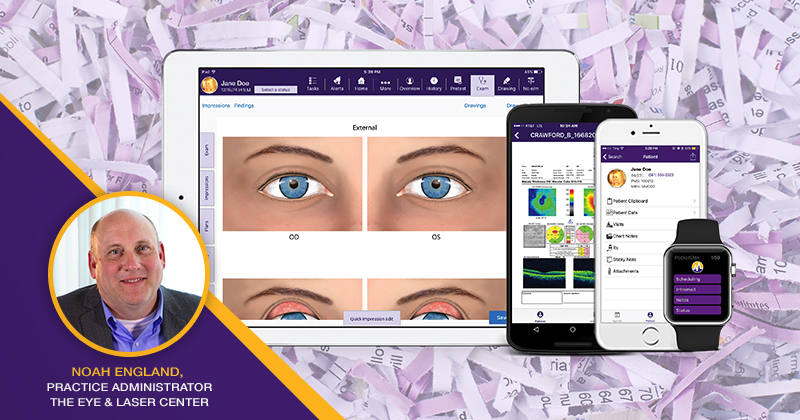Ophthalmology EHR Systems Rip Paper Records to Shreds

How better EHR data and faster access to critical information can help grow your practice and provide better care
This sponsored post originally appeared in Ophthalmology Management. You can read the original article here.
Recently, I queried EMA, our ophthalmology EHR system from Modernizing Medicine, on how many macular holes we referred out the previous month. All it took was a few clicks on my laptop to run the diagnosis codes and I had the answer: 40. A query that took mere seconds to run will have a lasting effect on my practice: Patients will no longer have to go elsewhere for vitreomacular repairs, because we now know it’s economically feasible for us to offer them to our patients.
In the past, we wouldn’t have done that kind of analysis. Instead, we would guess. We either ran the risk of being stuck with an $80,000 piece of equipment that’s not paying for itself, or we would miss out on the revenue of providing that service.
Thankfully, that’s no longer the case at the Eye & Laser Center in Lancaster, SC, where we have been leveraging the modmed® Ophthalmology suite, including Modernizing Medicine’s ophthalmology EHR system, ophthalmology Practice Management (PM), and Analytics platform, for the past two years. I’m a big data person and, in my opinion, you can’t run a successful ophthalmology practice in today’s highly regulated healthcare environment without easy access to EHR data that can tell you how your practice is doing and what you can do to deliver better patient care.
By enabling us to gather, extract, analyze, and act on data that used to take us hours—and sometimes days—to mine from paper records, modmed Ophthalmology helps us make smarter business and patient care decisions.
Changing the Paper-Heavy Culture
The Eye & Laser Center was started by a husband and wife team in 1982. Today, we have a staff of 52, including four ophthalmologists—one retina specialist and two cataract surgeons—and four optometrists who see an average of 150 patients a day.
When we decided to look for an ophthalmology EHR system, we were still a completely paper-based practice. In fact, one reason I was hired as practice administrator in June 2016 was because the penalties associated with MIPS, MACRA, and other regulations were hurting the practice financially.
Unfortunately, many among the staff feared electronic health records. They either didn’t understand them or computers, or how these tools could make their jobs easier. So I started small: I created an electronic calendar and showed everyone how to update it. I started using email to communicate to all office staff. In addition, I started scanning everything I could: patient charts, accounts receivables, accounts payables and the surgery books.
Shopping for an Ophthalmology EMR and Practice Management System: Making a List
To begin our search, I created a committee consisting of the practice leadership team, the optical manager, and other key personnel. We developed and prioritized a list of more than 25 features and capabilities. Among the most important: full EHR and practice management integration, more than 500 site references, built-in analytics capabilities and excellent customer service.
Based on this list, we selected some 30 systems for web-based demos. We then cut the list to 10, for a second demo to refine our likes and dislikes. Finally, we picked three companies for on-site, in-person demos. We scored each system on how well it would work with our practice. For several reasons, modmed Ophthalmology emerged as the unanimous winner.
Full integration. First, modmed Ophthalmology was one of the few fully integrated systems we found. The suite doesn’t consist of separate EHR and ophthalmology practice management systems with a high-speed link between the two. Instead, the ophthalmology EHR and practice management both use the same database. The person in the back office can review the patient’s charges and the person in the clinic can look at the same patient’s chart simultaneously. That’s critical to efficiency.
Reference sites. Modernizing Medicine has plenty of reference sites. Their number told us that it was getting enough feedback to build a good product. It also told us that the company would have enough personnel to support us, especially with prompt updates as regulations change. A practice might as well stay on paper if its ophthalmology EHR system can’t help it meet regulatory requirements.
User-friendly. Another bonus is that the ophthalmology EHR system is very clinic friendly. Of the systems we evaluated, the clinical staff and the doctors both found it to be the easiest, most intuitive system to use.
Robust analytics. EMA has robust, built-in EMR data analytics. With some systems, I couldn’t simply query for certain data. Instead, I would have to pay the company to build and send me a report. With modmed Ophthalmology, for any data point I want to measure, I simply pull the data, drop it into an Excel spreadsheet, and run with it. That’s a very powerful capability.
Value. In my opinion, cost is the last thing you should consider. Not that it shouldn’t be a consideration, but you do get what you pay for. If you choose a cheap ophthalmology EHR system with limited capabilities, you’re no better off than you were with paper. Alternatively, if you invest in a quality EHR and ophthalmology practice management system, you can make sound decisions and make them much faster — and that is invaluable.
A Smooth, Thorough Ophthalmology EMR System Transition
A month before our go-live date, I set up a learning center in the break room with 10 computers to familiarize staff with the technology. We watched the Modernizing Medicine videos and read all the documents available online. We also held task-specific learning sessions of 15 to 20 minutes each.
Modernizing Medicine’s trainers then arrived for two weeks of training, followed by walk-throughs in which staff served as employees and patients in alternating cycles. Between each cycle, we reviewed workflows and made adjustments. We went live with modmed Ophthalmology on a reduced schedule the third week, and by the following Monday, we saw 129 patients and were out by 5:30 p.m.
Never Going Back to Paper
Most people here would say there’s no way they would go back to paper, and I’m one of them. Today, everyone has tablets, and every chart contains the same type of data in exactly the same order. No more lost charts and no more running around.
What’s more, modmed Ophthalmology’s analytical capabilities are exceptionally powerful. If we’re thinking about running a newspaper ad in Rock Hill, for example, I can instantly see how many patients come from that zip code. A month after we run the ad, I can see how many new patients we’re getting from that area.
Taking care of patients is the most important part of an ophthalmology practice. But EMR data helps us determine how and when to improve our services. That’s also taking care of patients, and Modernizing Medicine’s ophthalmology EHR, practice management, and analytics technology helps us do that better than paper ever could.





